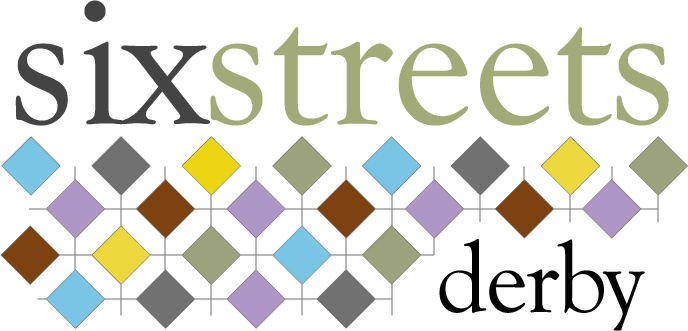Wheeldon Avenue
WHEELDON AVENUE
This photograph taken at the bottom of Wheeldon Avenue dates to the early 1950s. The curious wooden stands in the middle of the street were the barriers used by the Highways Department in the days before plastic cones.
We understand that in 1953 the repaving of the streets in the area started, with the replacement of the York stone kerbs by concrete. At the same time the blue brick pavements were covered with tarmac. This photograph must predate these road improvements as the blue brick pavements are visible, along with the cobbled gutters. One local resident, who worked for the Highways Department in the 1960s, believes that the Six Streets were chosen as a showpiece for street improvements commissioned by Derby Borough during coronation year. This could be why brass plaques were placed on each street to mark the event (the wooden backing boards still survive on White Street and Wheeldon Avenue).
It was thought that the trees were planted to mark the coronation, but this photograph suggests they may be earlier.
59 Wheeldon Avenue - Naraj
Some of the houses in this area have names carved above door or window lintels or others have carved stone panels set above groups of houses. Many have names such as ‘Oakdene’ and ‘Rose Villa’, while others such as ‘Limerick’ or ‘Glencoe’ may indicate fond memories for a past householder.
This house name - NARAJ - is perhaps the most intriguing house name in the Six Streets area.
The 1911 census revealed that James Hill, a letterpress printer, lived here with his wife Elizabeth, daughter Frances (aged 21) and servant Annie Hill (who may have been a relative). James and Frances were both born in India, and Frances in the Cuttack district of Orissa state (now known as Odisha) - ‘Naraj Marthapur’ is a village in this district.
James owned a printing business ‘J F Hill & Co’ on Cheapside in Derby. Letterpress printing is where movable type (often in the form of individual letters) is locked into the bed of a press; it is then inked and paper is rolled or pressed against it to make an impression. The type can be reused again and again - A fast typesetter can set a page in only a few minutes.
WHEELDON AVENUE AND WEST BANK CLOSE
These are some of the newest houses in the area which were built in 1960-1961.
This group of 11 chalet-style houses was built on land sold to a local builder in 1960 by the charitable trust that ran the Queen Victoria Memorial Home for Rest at West Parkfields House. Building plans show that originally 12 houses were planned for the area, but this was later reduced by one.
Designed by local architect Morrison & Partners (based on Belper Road) the houses were ready in 1961 and were offered for sale at £6,500. They featured under floor heating on the ground floor and insulated cavity walls.There was the option to choose coloured bathroom fittings and the style of the fireplace surround.
Locals living in the area referred to them as ‘The Noddy Houses’.



